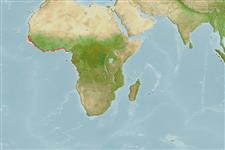>
Syngnathiformes (Pipefishes and seahorses) >
Syngnathidae (Pipefishes and seahorses) > Nerophinae
Etymology: Microphis: Greek, mikros = small + greek, ophis = serpent (Ref. 45335).
More on author: Kaup.
Environment: milieu / climate zone / depth range / distribution range
Ökologie
seewasser; süßwasser; brackwasser demersal; pH range: 7.5 - 8.2; dH range: 20 - 30. Tropical; 22°C - 26°C (Ref. 12468)
Africa: west coast of Africa, from Senegal to Angola (Ref. 81680).
Size / Gewicht / Alter
Maturity: Lm ? range ? - ? cm
Max length : 20.0 cm SL Männchen/unbestimmt; (Ref. 4509)
Kurzbeschreibung
Morphologie | Morphometrie
Rückenflossenstacheln (insgesamt): 0; Rückenflossenweichstrahlen (insgesamt): 38-54; Afterflossenstacheln 0; Afterflossenweichstrahlen: 2 - 3. Diagnosis: 41-44 bony rings (mode 43) (Ref. 81680), 19-21 (mode 20) trunk rings (before anus)(Ref. 57226, 81680) and 20-26 tail rings (behind anus)(Ref. 81680). 8.0-9.75 total subdorsal rings, 1.75-3.5, usually 2.5 or more, subdorsal trunk rings and 5.25-7.0, usually 5.75-6.5, subdorsal tail rings (Ref. 81680). Head length 4.8-5.6 (mean 5.2) times in SL (Ref. 57226, 81680). Snout 1.5-1.7 (mean 1.6) times in HL (Ref. 81680).
Coloration: general colour of preserved specimens dark brown, but pattern often highly variable within a single sample; lateral part of snout with dark brown blotches or stripes; body plain, blotched or with vague pale mid-lateral trunk stripe; dorsum and belly somewhat paler than flanks; ventral part of head light brown; opercle with numerous small dark brown spots and often a narrow horizontal dark, silvery stripe situated towards upper edge; caudal fin mainly brown with pale edging; other fins hyaline or with fin rays edged with brown; no consistent differences in preserved colouration of various subspecies (Ref. 81680).
Occurs in coastal rivers, streams and estuaries (Ref. 4127, 81680). Found in sea grasses and above sandy substrates in shallow water near shore a.o. (Ref. 81680). Ovoviviparous (Ref. 205). Breeds in fresh water (Ref. 81680). Male carries the eggs in a brood pouch found under the tail (Ref. 205). Eggs develop in the brood pouch for 1-3 weeks, until young of about 1.5 cm TL leave the pouch (Ref. 81680). Maximum reported total length for M. b. aculeatus 17.1 cm (Ref. 81680).
Life cycle and mating behavior
Geschlechtsreife | Fortpflanzung | Ablaichen | Eier | Fecundity | Larven
Eggs are attached to a kind of brood pouch, formed by two skin folds on the belly of the male (Ref. 13371).
Dawson, C.E., 1986. Syngnathidae. p. 281-287. In J. Daget, J.-P. Gosse and D.F.E. Thys van den Audenaerde (eds.) Check-list of the freshwater fishes of Africa (CLOFFA). ISNB, Brussels; MRAC, Tervuren; and ORSTOM, Paris. Vol. 2. (Ref. 4127)
IUCN Rote Liste Status (Ref. 130435)
Bedrohung für Menschen
Harmless
Nutzung durch Menschen
Fischereien:
Mehr Information
Alter/GrößeWachstumLänge-GewichtLänge-LängeLängenhäufigkeitenMorphometrieMorphologieLarvenLarven Pop.Dyn.RekrutierungDichteBRUVS
ReferenzenAquakulturAquakultur ProfilZuchtlinienGenetikElectrophoresesVererbbarkeitKrankheitenVerarbeitungNutrientsMass conversion
PartnerBilderStamps, Coins Misc.LauteCiguateraGeschwindigkeitSchwimmstilKiemenoberflächeOtolithsGehirngrößeSehfähigkeit
Tools
Zusatzinformationen
Download XML
Internet Quellen
Estimates based on models
Preferred temperature (Ref.
123201): 25.2 - 28, mean 27.3 °C (based on 171 cells).
Phylogenetic diversity index (Ref.
82804): PD
50 = 0.5000 [Uniqueness, from 0.5 = low to 2.0 = high].
Bayesian length-weight: a=0.00085 (0.00032 - 0.00224), b=3.04 (2.81 - 3.27), in cm total length, based on LWR estimates for this (Sub)family-body shape (Ref.
93245).
Trophic level (Ref.
69278): 3.4 ±0.4 se; based on size and trophs of closest relatives
Widerstandsfähigkeit (Ref.
120179): hoch, Verdopplung der Population dauert weniger als 15 Monate. (Preliminary K or Fecundity.).
Fishing Vulnerability (Ref.
59153): Low vulnerability (14 of 100).
